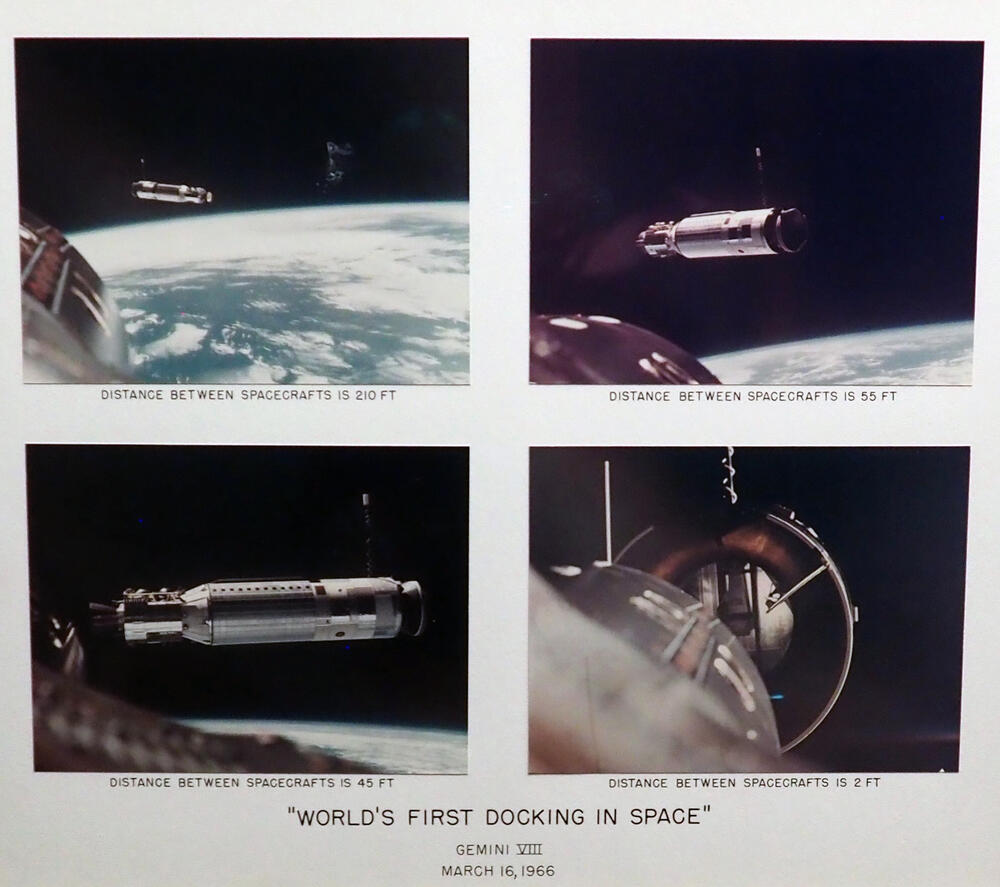
Section Branding
Header Content
Georgia Today: Folkston ICE center doubles capacity; Cuts to Job Corps program; Space photo exhibit
Primary Content
On the Wednesday, June 4 edition of Georgia Today: An ICE processing center in Southeast Georgia more than doubles its capacity as part of a nationwide federal crackdown on immigration; Federal cuts to the Job Corps program affect at-risk youth in Atlanta; And we'll tell you how some rare photographs taken in space ended up in Columbus, Ga.

Orlando Montoya: Hello and welcome to the Georgia Today podcast. Here on this podcast we bring you the latest reports from the GPB newsroom. On today's episode, an ICE processing center in Southeast Georgia is set to more than double its capacity as part of a nationwide federal crackdown on immigration. Federal cuts to the Job Corps program affect at-risk youth in Atlanta. And we'll tell you how some rare photographs taken in space ended up in Columbus.
Sean Crewson: He said, "Hey, I have a few pieces of memorabilia from when my brother walked on the surface of the moon. We were just wondering if you'd like to put that on display." And of course I said that would be fantastic.
Orlando Montoya: Today is Wednesday, June 4. I'm Orlando Montoya, and this is Georgia Today.
Story 1:
Orlando Montoya: An Immigration and Customs Enforcement Processing Center in Southeast Georgia's Charlton County is set to more than double its capacity. As GPB's Grant Blankenship explains, it's part of a nationwide expansion of ICE detention.
Grant Blankenship: The Folkston ICE Processing Center is owned by a for-profit company called The GEO Group. The company also owns the nearby D. Ray James Correctional Institute, which it once operated for the Federal Bureau of Prisons. Should the Charlton County Commission approve their role as a pass-through for money from ICE to GEO group, the two properties will merge, and that what ICE says are close to 2,000 more beds for people in the earliest phase of immigration detention. According to ICE, the expansion would make Folkston their largest processing center. For their role, Charlton County stands to make seven times as much money as compared to the older deal with ICE and GEO Group, whose stock price rocketed after President Trump's reelection. For GPB News, I'm Grant Blankenship in Macon.
Story 2:
Orlando Montoya: A federal judge has thrown out murder charges against a former Atlanta police officer who shot and killed an unarmed man hiding in a closet. U.S. District Judge Michael Brown ruled yesterday that Sung Kim acted in self-defense and shouldn't face charges in the 2019 shooting of 21-year-old Jimmy Acheson. Brown says the shooting was quote, "textbook self-defense." Atlanta activists call Acheson's death an example of unjustified police violence against Black people. Family members say Achesons was raising his hands to surrender when Kim shot him in the face. Kim and other officers testified that they believed Achesson's move was threatening. Brown ruled that fear was reasonable and justified the shooting.
Story 3:
Orlando Montoya: Georgia state Rep. Derrick Jackson, a metro Atlanta Democrat, said yesterday that he's running for governor. He'll join three other Democrats in the race. Jackson is a U.S. Navy veteran. He was elected to the state House in 2016. And in the raise for state attorney general, state Sen. Brian Strickland said yesterday that he is running for the post. The Republican from McDonough was elected into the Georgia Senate in 2018, after serving in the Georgia House since 2013.
Story 4:
Orlando Montoya: Yesterday on this podcast, we told you how federal cuts to the Job Corps program are kicking people out of their jobs and in some cases their homes in Albany. Those cuts are affecting the Job Corps program across the state, including for at-risk youth in Atlanta. GPB's Amanda Andrews reports, local officials in the city of South Fulton are asking for help.
Amanda Andrews: Over 400 students and 140 staff were recently notified the Job Corps program in South Fulton would shut down at the end of the month. Many students in the program rely on it to provide housing, financial stability, and vocational training. Manager Janita Beckles is facing unemployment after 16 years with Job Corps, but she's more worried about the students.
Janita Beckles: We have hundreds that have nowhere to go, so we are trying to bring awareness and advocacy before these young people are displaced and unsheltered and leave off of our campuses nationwide.
Amanda Andrews: South Fulton City Council members are asking the public to support a resolution asking the federal government to restore funding to the program created by Congress in 1964. For GPB News, I'm Amanda Andrews.

Story 5:
Orlando Montoya: Cotton has long been a staple crop for Georgia's farmers, but with shrinking demand, some farmers are bowing out. GPB's Chase McGee has more.
Chase McGee: Cotton was first planted in Georgia in 1734, but nearly 300 years later the crop has fallen out of favor with manufacturers in favor of cheaper, oil-based products like polyester. Camp Hand is the University of Georgia's extension cotton agronomist. He says that decreased demand has pushed many farmers out of the industry.
Camp Hand: There's a lot of farmers who've gotten out. There's a lot farmers who are only farming this year because of the federal assistance in response to Hurricane Helene.
Chase McGee: Hand notes that polyester use can contribute to microplastic pollution, and that Georgia's businesses can look to cotton as a sustainable, high-quality product if they want to support a shrinking economy. For GPB News, I'm Chase McGee.
Story 6:
Orlando Montoya: The Georgia Department of Transportation is asking for public input on a $450 million plan to widen a key stretch of Interstate 16 west of Savannah. The project would expand the highway from two lanes to three in both directions, covering 32 miles from the Interstate 95 interchange to Georgia 67 in Bullitt County. Twenty bridges along the route would also be widened or replaced. Agency officials say the upgrades are needed to ease congestion from truck traffic tied to the Port of Savannah and the recently opened Hyundai electric vehicle plant in Bryan County. Two open houses are planned next week for this project, June 11 in Statesboro and June 12 in Bloomingdale.
Story 7:
Orlando Montoya: A new nonprofit organization aims to redevelop an area whose boosters call it the Black Wall Street of Columbus. Community leaders and activists created the Historic Liberty District Foundation to advise Columbus City Council about neighborhood development. It's modeled on Columbus nonprofits Midtown Inc. and Uptown Columbus
Story 8:
Orlando Montoya: Macon-Bibb County has selected a manager for its proposed new arena project. County commissioners yesterday chose Memphis-based MFA Program Management for the role. The project at the current site of the Macon Coliseum is paid for by a voter-approved sales tax that won't start being collected until later this year.

Story 9:
Orlando Montoya: A new exhibit that opened in Columbus yesterday offers a rare glimpse of photos taken from space and the surface of the moon. A partnership between Columbus State University's Beau Bartlett Center and its Coca-Cola Space Science Center will run through August 2. It features hundreds of photos from a Gemini 8, Apollo 9, and Apollo 15 astronaut. Think lonely capsules floating above Earth, barren moonscapes, and sepia-tinged images of space exploring in its prime. As to how the photos were taken and how they ended up in Columbus, I spoke to the Science Center's director, Shawn Cruzen.
Shawn Cruzen: The exhibition is a collection of artifacts from astronaut David Scott. And a number of years ago, I made the acquaintance of Dave Scott's brother. His name is Tom Scott. Tom actually worked for the Chamber of Commerce here in Columbus, Ga. And Tom came in one day and asked me, he said, "hey, I have a few pieces of memorabilia from when my brother walked on the surface of the moon. We were just wondering if you'd like to put that on display at your space science center for a period of time." And of course I said, "yes, we would love to put that on the display, that would be fantastic." So they put some items on display with us for a temporary exhibit. And after about, oh, I don't know, six to eight weeks, something like that, Tom came back in and said, "hey, I talked to my brother, Dave, we've decided we're gonna let you keep those pieces permanently. And we have a few other ones that we'd like to pass on to you as well." So over the years, our collection from the Scott brothers has just grown.
Orlando Montoya: Let's talk a little bit about the Scott brothers, specifically David Scott. Can you talk a bit about his accomplishments? You mentioned he walked on the moon, but tell us a little about his life.
Shawn Cruzen: So David Scott was actually a test pilot in the United States Air Force, which already that is a fantastic accomplishment. And of course, when NASA was recruiting their astronauts, these are exactly the kind of people that they were going after. So when NASA brought on their third class of astronauts, their third group of astronauts, he came on with a crew that was working on the Gemini program. And Gemini 8, very important because of the docking of two spacecraft. Apollo 9, very important as a dress rehearsal for the moon landing. And then Apollo 15, a very important mission because of the much greater impact of being able to travel around the lunar surface to gather up more rock samples for lunar geology.
Orlando Montoya: Scott is one of only 12 humans ever to have walked on the moon. I'm curious as to how you take a photograph on the moon.
Shawn Cruzen: You know, it's funny, the whole photographs on the moon. So first of all, their vehicles had cameras that were mounted and there were both still cameras and video cameras. So much like, you know, if we, if were going to go on a trip, we might put GoPros, you know, all around our vehicle. All they had — you know, the GoPros of the day — were very primitive video cameras, CRT cameras, and then also some Hasselblad still photography cameras. So they actually had film and they're actually taking images with film on the moon. And so a lot of the pictures that we see from the moon are either taken from the lander, which they called the lunar module, or from the lunar rover, which the Apollo 15 mission with David Scott was the first mission to have a lunar rover, a car that could actually drive around on the surface of the moon.
Orlando Montoya: I'm seeing a photo that has the lunar module, that has the American flag and an astronaut with his arm at attention. Is that Scott?
Shawn Cruzen: Yeah. That image is a picture of David Scott on the surface of the moon. It was taken by his fellow moon walker, James Erwin. And so that's a photograph of the two astronauts, one taking the picture, one standing near the flag shortly after they stepped foot on the surface of the moon and planted that American flag down there.
Orlando Montoya: I'm also curious about the idea of photographs like this existing in, I don't know, a basement or a attic or a bedroom, maybe on a wall somewhere. Where have these photographs been all this time?
Shawn Cruzen: So many of these photographs are historic photographs. And of course, you can find these same images in NASA archives online and other places like that. But the images that we have were physical prints that belonged to David Scott. So David either had them in his own home or he had them his home for a period of time and then gave them to his brother Tom and Tom had them into his home. And so they're really, you know, family collection. And now we are putting them on exhibit, but we're also working to preserve them long term and get them in a state where they're archived and they're protected so that they can be shared for people in perpetuity.
Orlando Montoya: Now, David Scott is 92 years old now. Do we know how he feels about this being in the collection and on display? Did you get to talk to him, for example?
Shawn Cruzen: So I — there's a few things I can tell you. First of all, I have not been able to speak to him directly about this exhibition. Although a couple of things I could tell you, I was fortunate enough to meet David Scott at the anniversary — at the 50th anniversary of the Apollo 9 mission. That was just a few years ago. And I got to speak with him then after they had already donated a few pieces to the Space Science Center. And one of the reasons that David Scott is particularly happy about doing that is because he believes in our mission. And our mission is to inspire and educate the next generation of scientists, engineers and science educators.
Orlando Montoya: And my last question is sort of based on the fact that we are a 21-station statewide radio network and we're all about letting people know about the things in the state that they might not know about and — people might know of, you know, Titusville, Fla., and Huntsville, Ala., and Johnson Space Science and all that. But why do we have Space Science Center in Columbus?
Shawn Cruzen: Yeah, so the Coca-Cola Space Science Center in Columbus, Ga., is part of Columbus State University. We're owned and operated by the university. I'm on the faculty here. My teaching mission at Columbus State University is in space science. I teach astronomy and physics here at the actual Space Science Center. So it's a classroom facility as well as a museum and space science center that's open to the public. We opened in 1996, which was the year the Olympics were coming to town. And so the city of Columbus was looking for something to do that was interesting for the Olympics and would add to the draw of the city, but also they wanted to include something that would benefit the educational mission of the local school district, and quite frankly, the region. And so we serve a region of people that are No. 1, interested in space science and they can just come see us, but also No. 2, we're trying to actually help educate both students and teachers to be better prepared to understand concepts of space travel, the concepts of our physical universe, and just basic concepts of physical science. We have a planetarium facility here. We also have an observatory. We have the largest collection of space shuttle artifacts in the state of Georgia and many other pieces that have flown with astronauts in space or been part of space shuttle and Apollo missions. So we're really excited when people find out about us and want to come down and see us. I think most of those people are very pleasantly surprised by our programs that we have here, our facility that we here, by the magnitude of our collection of artifacts that are on display here in Columbus, Ga.
Orlando Montoya: Thank you for joining me, Dr. Sean Cruzen of the Coca-Cola Space Science Center in Columbus. Appreciate it.
Orlando Montoya: And that's it for today's edition of Georgia Today. GPB's website, GPB.org/news, has many of the stories that you hear on this podcast in greater detail and a lot more from around the world and the nation. If you haven't yet hit subscribe on this podcast, take a moment to do that now. That'll help you to keep us current in your feed and it'll help us by keeping us current in your feed. We'd love to hear your feedback. Story ideas and suggestions, send them to us at GeorgiaToday@GPB.org. I'm Orlando Montoya. We'll be with you again tomorrow for another episode of Georgia Today.
---
For more on these stories and more, to go GPB.org/news



